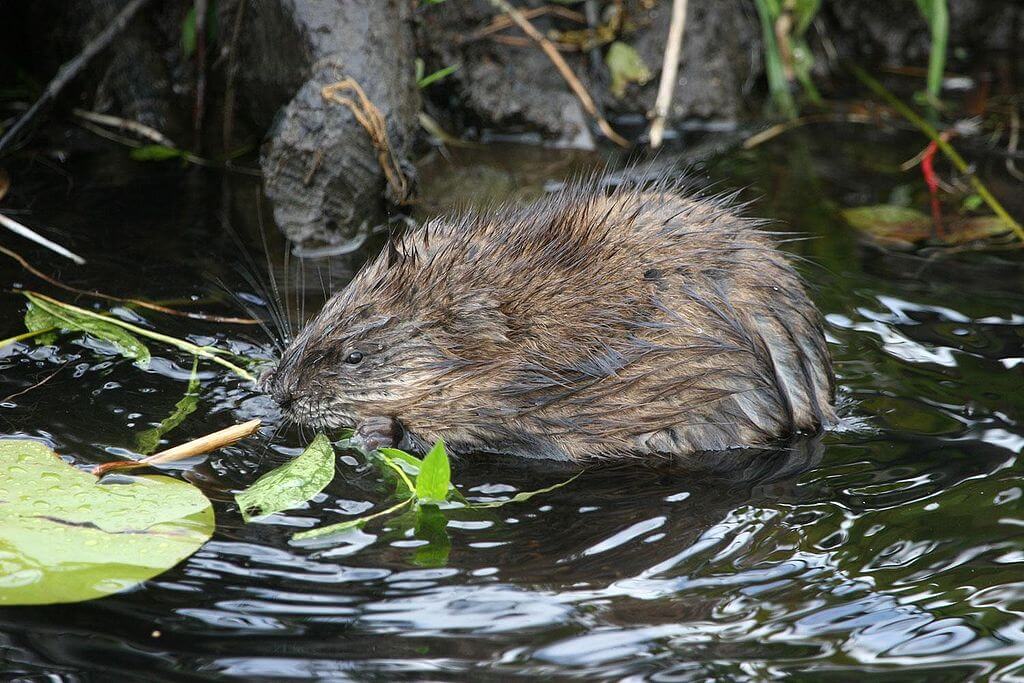Montana’s Other Aquatic Engineer
By Zola Kell
Broadcast 2.2022 and 2.7 & 2.10.2024

Photo by Alan D. Wilson, www.naturespicsonline.com, CC 2.5.
Listen:
Spring and summer mornings, on my way to an early fitness class, I often end up taking a few extra minutes on my walk to admire the pond in the park. As the weather warms up, I tend to linger longer. It seems like a fairly innocuous little pond, just right for showing kids how to catch fish, but it treats me to glimpses of dragonflies and other darting insects, the occasional splash and rippling water of a fish breaking the surface, and sometimes, like today, a line of bubbles moving underneath the water that is unmistakable.
I watch the trail of bubbles move out towards the center of the pond, hoping that this time, the creature making them won’t hold its breath for the full twelve minutes it’s able to and that I’ll actually see its face. I am rewarded for my patience when a small brown head appears on the surface and I suddenly exhale, not even realizing that I, too, have been holding my breath.
I don’t get a long look at the little creature that has deigned to show itself this morning before it moves swiftly back under the water. Seeming to simply fold itself in half as it disappears, its long, hairless, slinky tail rising above the water like part of an infinity loop making a slow wave goodbye.
It’s a muskrat.
Smaller than a beaver, bigger than the common rat, these curious rodents are actually aquatic voles. They are crepuscular, meaning they are most active at dawn and dusk. I always feel lucky when I see them, particularly in urban environments, because it feels like a window into a completely different world. Unlike some urban-adapted species, muskrats don’t find their food in our garbage, or make their homes in our crawlspaces and attics. They just happen to live alongside us, foraging for aquatic plants and building their dens in the soft mud and clay of the banks of streams and ponds.
Though not as famous for engineering as their larger counterpart the beaver, muskrats have a little bit of “city planner” in them as well. Over time they develop well-worn trails through nibbled underwater vegetation that lead to their dens and favored feeding areas. Muskrats are specially adapted to their aquatic lifestyles, with protruding front teeth that stick out beyond their lips. These allow them to bite, gnaw, and even carry sticks and plants without letting water into their mouths.
If you’re lucky enough to live in a place where you can watch out for muskrats, you may have noticed piles of vegetation building up on the surface of the water, like little islands. These push-ups, or feeding mats, are platforms often made up of mud and the reedy parts of plants that remain after the muskrat has eaten the tender shoots near the root.
As these rodents don’t hibernate, they continue to make similar push-ups throughout the winter. Chewing holes into the surface of the ice and covering them with vegetation ensures that those gaps will remain open all winter long. These holes are essential for their foraging trips, as they use them to rest and breathe in between dives. When a muskrat dives beneath the water, its heartbeat slows down, the smaller blood vessels in its body constrict, and oxygenated blood is diverted towards the heart and brain – effectively pressing “pause” for the duration of the dive on their less essential organs. This thermoregulation helps protect them from hypothermia.
That means you can look out for these elusive little critters year-round – just watch for a tell-tale line of bubbles under the ice. If you spot some, you can be pretty sure that it is a muskrat following one of its underwater foraging trails. I know that I’ll keep visiting the pond in the park, gladly braving the chilly winter mornings in hope of a glimpse of one of these marvelous creatures.
Every week since 1991, Field Notes has inquired about Montana’s natural history. Field Notes are written by naturalists, students, and listeners about the puzzle-tree bark, eagle talons, woolly aphids, and giant puffballs of Western, Central and Southwestern Montana and aired weekly on Montana Public Radio.
Click here to read and listen to more Field Notes. Field Notes is available as a podcast! Subscribe on iTunes, Google Play, or wherever you listen to podcasts.
Interested in writing a Field Note? Contact Allison De Jong, Field Notes editor, at adejong [at] montananaturalist [dot] org or 406.327.0405.
Want to learn more about our programs as well as fun natural history facts and seasonal phenology? Sign up for our e-newsletter! You can also become a member and get discounts on our programs as well as free reciprocal admission to 300+ science centers in North America!












